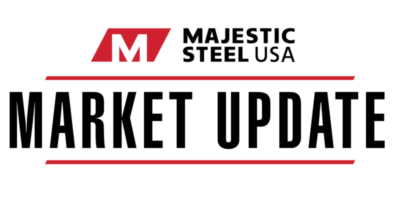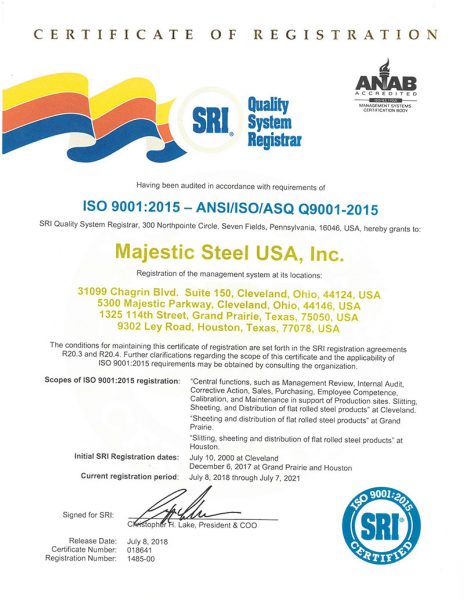Market Update | February 9, 2022
THE U.S. & JAPAN SET TO UPDATE SECTION 232 AGREEMENT
The U.S. and Japan are set to announce an agreement that will end the 25% Section 232 tariff on Japanese steel imports. Since Section 232 went into place the U.S. averages 55k-60k tons/month of HDG imports. Before 232, the U.S. was averaging 80k tons/month. This comes after the U.S. reached a deal with Europe easing tariffs. U.S. steelmakers have warned that Europe and Japan could unknowingly import metal from restricted countries.
INPUT COSTS
Zinc pricing remained firm this week after a sharp increase to start the new year, remaining over $1.60/lb for thirty-five consecutive readings.
– Zinc pricing remained near $1.65/lb this week; holding at that level since the week before Christmas.
– However, longer-term forecasts expect pricing to return to the recent $1.40/lb.-$1.45/lb. average.
Spot iron ore pricing was virtually flat this week, holding at $149.95/dmt.
– While spot iron ore pricing is virtually flat w/w, pricing is still up 19.5% m/m.
Pacific basin met coal pricing continued to climb this week, hitting a fresh all-time high.
– Met coal pricing climbed to $444/mt, up 8.6% from last week.
Weaker sheet mill order books, increased imports (finished, semi, and scrap), and continued uncertainty around the auto industry have helped prime scrap pricing to soften further in February.
– Prime scrap pricing decline $25/gt. in February to $495/gt., after dropping $60/gt. in January.
SUPPLY
Last week domestic raw steel production slipped for the third consecutive week, sliding to its lowest weekly output since early May of last year.
– U.S. steelmakers produced 1.785 million tons at an 81.1% utilization rate.
– Year-to-date production is 2.6% above the total from the same period last year.
Based on preliminary import licenses, the daily average import level for February (7 days) is down 10.3% m/m.
– Excluding the volatile Brazilian semi-finished imports, the current pace is down 12.6% m/m.
The U.S. and Japan are set to announce an agreement that will end the 25% Section 232 tariff on steel imports from Japan.
– U.S. steelmakers have warned that Europe and Japan could unknowingly import metal from restricted countries and then export that to the U.S., flooding the market.
– The U.S. went from averaging 80,000 tons/month of HDG imports from Japan in 2017/2018 to averaging between 55k-60k tons/month since 232 went into place.
– This deal comes after the U.S. reached a deal in October with the European Union to ease tariffs on steel and aluminum from Europe.
The January service center flat rolled inventory on hand increased to its highest level since January 2019.
– While the inventory on hand increased, the improving shipping activity helped to push the flat rolled months of supply lower in January, sliding to 2.35 months from 2.58 months previously.
– January coated service center inventories increased for the seventh consecutive month and are at their highest level since July 2020.
– The recent climb in inventories helped to push January’s inventory above year-ago levels for the fourth consecutive month after a string of twelve consecutive year-over-year declines.
– Current inventory, when combined with the January’s coated shipment rate, equates to 1.97 months (41.3 days) of supply.
DEMAND
There may be some demand hope on the horizon for the carbon flat rolled market and auto specifically.
– Last week Ford announced it expects 2022 sales to pick up as much as 15% compared to last year, which could translate to an increase of 286,000 more vehicles sold in the U.S. this year.
– GM expects to boost its sales by as much as 665,000 vehicles, adding to potential steel demand from the auto industry.
ECONOMIC
The Logistics Managers Index increased in January, climbing nearly 2.0 points from December to 71.9.
– The index in January was boosted by an increasing growth rate for transportation utilization.
– Inventory costs, inventory levels, warehouse utilization, warehouse prices, and transportation prices, all increased as well, just at a slightly slower rate than in December.
– Warehousing capacity and transportation capacity are both contracting, which points to further price increases for both.
This material, information and analyses (the “Content”) may include certain statements, estimates and projections prepared with respect to, among other things, historical data and anticipated performance. Content may reflect various assumptions by Majestic Steel USA, Inc. concerning anticipated results that are inherently subject to significant economic, competitive and other uncertainties and contingencies and have been included for illustrative purposes. Content is provided AS-IS.

